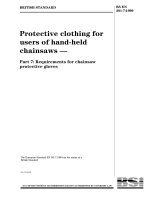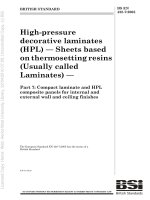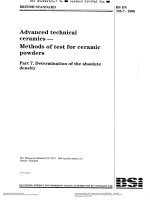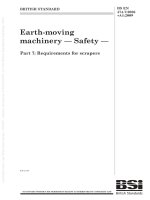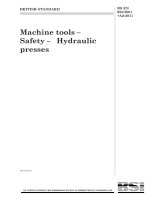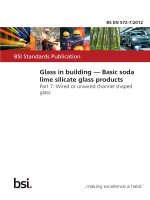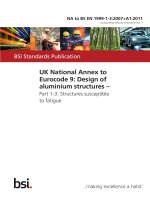Bsi bs en 61850 7 3 2011
Bạn đang xem bản rút gọn của tài liệu. Xem và tải ngay bản đầy đủ của tài liệu tại đây (1.3 MB, 94 trang )
BS EN 61850-7-3:2011
BSI Standards Publication
Communication networks
and systems for power utility
automation
Part 7-3: Basic communication structure –
Common data classes
NO COPYING WITHOUT BSI PERMISSION EXCEPT AS PERMITTED BY COPYRIGHT LAW
raising standards worldwide™
BS EN 61850-7-3:2011 BRITISH STANDARD
National foreword
This British Standard is the UK implementation of EN 61850-7-3:2011. It is
identical to IEC 61850-7-3:2010. It supersedes BS EN 61850-7-3:2003 which
is withdrawn.
The UK participation in its preparation was entrusted to Technical Committee
PEL/57, Power systems management and associated information exchange.
A list of organizations represented on this committee can be obtained on
request to its secretary.
This publication does not purport to include all the necessary provisions of a
contract. Users are responsible for its correct application.
© BSI 2011
ISBN 978 0 580 60650 2
ICS 33.200
Compliance with a British Standard cannot confer immunity from
legal obligations.
This British Standard was published under the authority of the Standards
Policy and Strategy Committee on 31 March 2011.
Amendments issued since publication
Amd. No. Date Text affected
EUROPEAN STANDARD BS EN 61850-7-3:2011
NORME EUROPÉENNE
EUROPÄISCHE NORM EN 61850-7-3
ICS 33.200 February 2011 Supersedes EN 61850-7-3:2003
English version
Communication networks and systems for power utility automation -
Part 7-3: Basic communication structure -
Common data classes
(IEC 61850-7-3:2010)
Réseaux et systèmes de communication Kommunikationsnetze und -systeme für
pour l'automatisation des systèmes die Automatisierung in der elektrischen
électriques - Energieversorgung -
Partie 7-3: Structure de communication de Teil 7-3: Grundlegende
base - Kommunikationsstruktur -
Classes de données communes Gemeinsame Datenklassen
(CEI 61850-7-3:2010) (IEC 61850-7-3:2010)
This European Standard was approved by CENELEC on 2011-01-20. CENELEC members are bound to comply
with the CEN/CENELEC Internal Regulations which stipulate the conditions for giving this European Standard
the status of a national standard without any alteration.
Up-to-date lists and bibliographical references concerning such national standards may be obtained on
application to the Central Secretariat or to any CENELEC member.
This European Standard exists in three official versions (English, French, German). A version in any other
language made by translation under the responsibility of a CENELEC member into its own language and notified
to the Central Secretariat has the same status as the official versions.
CENELEC members are the national electrotechnical committees of Austria, Belgium, Bulgaria, Croatia, Cyprus,
the Czech Republic, Denmark, Estonia, Finland, France, Germany, Greece, Hungary, Iceland, Ireland, Italy,
Latvia, Lithuania, Luxembourg, Malta, the Netherlands, Norway, Poland, Portugal, Romania, Slovakia, Slovenia,
Spain, Sweden, Switzerland and the United Kingdom.
CENELEC
European Committee for Electrotechnical Standardization
Comité Européen de Normalisation Electrotechnique
Europäisches Komitee für Elektrotechnische Normung
Management Centre: Avenue Marnix 17, B - 1000 Brussels
© 2011 CENELEC - All rights of exploitation in any form and by any means reserved worldwide for CENELEC members.
Ref. No. EN 61850-7-3:2011 E
BS EN 61850-7-3:2011
EN 61850-7-3:2011 - 2 -
Foreword
The text of document 57/1087/FDIS, future edition 2 of IEC 61850-7-3, prepared by IEC TC 57, Power
systems management and associated information exchange, was submitted to the IEC-CENELEC
parallel vote and was approved by CENELEC as EN 61850-7-3 on 2010-12-07.
This European Standard supersedes EN 61850-7-3:2003.
Compared to EN 61850-7-3:2003, this edition:
– defines new common data classes used for new standards defining object models for other domains
based on EN 61850 and for the representation of statistical and historical data;
– provides clarifications and corrections to EN 61850-7-3:2003.
Attention is drawn to the possibility that some of the elements of this document may be the subject of
patent rights. CEN and CENELEC shall not be held responsible for identifying any or all such patent
rights.
The following dates were fixed:
– latest date by which the EN has to be implemented (dop) 2011-09-07
at national level by publication of an identical
national standard or by endorsement
– latest date by which the national standards conflicting (dow) 2013-12-07
with the EN have to be withdrawn
Annex ZA has been added by CENELEC.
__________
Endorsement notice
The text of the International Standard IEC 61850-7-3:2010 was approved by CENELEC as a European
Standard without any modification.
In the official version, for Bibliography, the following notes have to be added for the standards indicated:
IEC 61850-8 series NOTE Harmonized in EN 61850-8 series (not modified).
IEC 61850-9 series NOTE Harmonized EN 61850-9 series (not modified).
__________
BS EN 61850-7-3:2011
- 3 - EN 61850-7-3:2011
Annex ZA
(normative)
Normative references to international publications
with their corresponding European publications
The following referenced documents are indispensable for the application of this document. For dated
references, only the edition cited applies. For undated references, the latest edition of the referenced
document (including any amendments) applies.
NOTE When an international publication has been modified by common modifications, indicated by (mod), the relevant EN/HD
applies.
Publication Year Title EN/HD Year
IEC/TS 61850-2 - -
IEC 61850-7-1 - Communication networks and systems in - -
substations -
IEC 61850-7-2 - Part 2: Glossary -
IEC 61850-7-4 - Communication networks and systems in EN 61850-7-1 -
substations -
ISO 4217 - Part 7-1: Basic communication structure for -
IEEE C37.118 2005 substation and feeder equipment - Principles -
and models
Communication networks and systems for EN 61850-7-2
power utility automation -
Part 7-2: Basic information and
communication structure - Abstract
communication service interface (ACSI)
Communication networks and systems for EN 61850-7-4
power utility automation -
Part 7-4: Basic communication structure -
Compatible logical node classes and data
object classes
Codes for the representation of currencies -
and funds
IEEE Standard for Synchrophasors for Power -
Systems
– 2 – BS EN 61850-7-3:2011
61850-7-3 Ó IEC:2010
CONTENTS
INTRODUCTION ............................................................................................................ 8
1 Scope...................................................................................................................... 9
2 Normative references................................................................................................ 9
3 Terms and definitions.............................................................................................. 10
4 Abbreviated terms .................................................................................................. 10
5 Conditions for attribute inclusion .............................................................................. 10
6 Constructed attribute classes ................................................................................... 11
6.1 General......................................................................................................... 11
6.2 Quality .......................................................................................................... 11
6.2.1 Overview ............................................................................................ 11
6.2.2 Validity............................................................................................... 12
6.2.3 Detail quality ...................................................................................... 13
6.2.4 Source ............................................................................................... 14
6.2.5 Test ................................................................................................... 14
6.2.6 Frozen by operator .............................................................................. 14
6.2.7 Quality in the client server context ........................................................ 15
6.2.8 Relation between quality identifiers ....................................................... 16
6.3 Analogue value .............................................................................................. 18
6.4 Configuration of analogue value ...................................................................... 18
6.5 Range configuration ....................................................................................... 19
6.6 Step position with transient indication............................................................... 19
6.7 Pulse configuration......................................................................................... 20
6.8 Originator ...................................................................................................... 20
6.9 Unit definition ................................................................................................ 21
6.10 Vector definition............................................................................................. 21
6.11 Point definition............................................................................................... 22
6.12 CtlModels definition........................................................................................ 22
6.13 SboClasses definition ..................................................................................... 22
6.14 Cell............................................................................................................... 22
6.15 CalendarTime definition .................................................................................. 23
7 Common data class specifications............................................................................ 25
7.1 General......................................................................................................... 25
7.2 Name spaces................................................................................................. 25
7.3 Common data class specifications for status information .................................... 25
7.3.1 Application of services ......................................................................... 25
7.3.2 Single point status (SPS) ..................................................................... 26
7.3.3 Double point status (DPS) .................................................................... 27
7.3.4 Integer status (INS) ............................................................................. 27
7.3.5 Enumerated status (ENS)..................................................................... 28
7.3.6 Protection activation information (ACT) ................................................. 28
7.3.7 Directional protection activation information (ACD) ................................. 29
7.3.8 Security violation counting (SEC).......................................................... 30
7.3.9 Binary counter reading (BCR) ............................................................... 30
7.3.10 Histogram (HST) ................................................................................. 31
BS EN 61850-7-3:2011 – 3 –
61850-7-3 Ó IEC:2010
7.3.11 Visible string status (VSS).................................................................... 31
7.4 Common data class specifications for measurand information............................. 32
7.4.1 Application of services ......................................................................... 32
7.4.2 Measured value (MV) .......................................................................... 33
7.4.3 Complex measured value (CMV)........................................................... 34
7.4.4 Sampled value (SAV) .......................................................................... 35
7.4.5 Phase to ground/neutral related measured values of a three-phase
7.4.6 system (WYE)..................................................................................... 36
Phase to phase related measured values of a three-phase system
(DEL) ................................................................................................. 37
7.4.7 Sequence (SEQ) ................................................................................. 38
7.4.8 Harmonic value (HMV)......................................................................... 39
7.4.9 Harmonic value for WYE (HWYE) ......................................................... 40
7.4.10 Harmonic value for DEL (HDEL) ........................................................... 41
7.5 Common data class specifications for controls .................................................. 42
7.5.1 Application of services ......................................................................... 42
7.5.2 Controllable single point (SPC) ............................................................. 43
7.5.3 Controllable double point (DPC) ........................................................... 44
7.5.4 Controllable integer status (INC)........................................................... 45
7.5.5 Controllable enumerated status (ENC) .................................................. 46
7.5.6 Binary controlled step position information (BSC) ................................... 47
7.5.7 Integer controlled step position information (ISC) ................................... 48
7.5.8 Controllable analogue process value (APC) ........................................... 49
7.5.9 Binary controlled analog process value (BAC) ........................................ 50
7.6 Common data class specifications for status settings ......................................... 51
7.6.1 Application of services ......................................................................... 51
7.6.2 Single point setting (SPG) .................................................................... 51
7.6.3 Integer status setting (ING) .................................................................. 52
7.6.4 Enumerated status setting (ENG).......................................................... 52
7.6.5 Object reference setting (ORG) ............................................................ 53
7.6.6 Time setting group (TSG)..................................................................... 53
7.6.7 Currency setting group (CUG) .............................................................. 54
7.6.8 Visible string setting (VSG) .................................................................. 54
7.7 Common data class specifications for analogue settings .................................... 55
7.7.1 Application of services ......................................................................... 55
7.7.2 Analogue setting (ASG) ....................................................................... 56
7.7.3 Setting curve (CURVE) ........................................................................ 57
7.7.4 Curve shape setting (CSG) .................................................................. 58
7.8 Common data class specifications for description information ............................. 59
7.8.1 Application of services ......................................................................... 59
7.8.2 Device name plate (DPL) ..................................................................... 60
7.8.3 Logical node name plate (LPL) ............................................................. 61
7.8.4 Curve shape description (CSD)............................................................. 62
8 Data attribute semantic ........................................................................................... 63
Annex A (normative) Value range for units and multiplier ................................................. 78
Annex B (informative) Functional constraints .................................................................. 81
Annex C (normative) Tracking of configuration revisions................................................... 83
Annex D (normative) SCL enumerations ......................................................................... 84
– 4 – BS EN 61850-7-3:2011
61850-7-3 Ó IEC:2010
Bibliography................................................................................................................. 90
Figure 1 – Quality identifiers in a single client-server relationship ...................................... 15
Figure 2 – Quality identifiers in a multiple client-server relationship ................................... 15
Figure 3 – Interaction of substitution and validity ............................................................. 17
Figure 4 – Configuration of command output pulse........................................................... 20
Figure 5 – Cell definition ............................................................................................... 23
Figure 6 – Two-dimensional curve represented by CSG.................................................... 58
Figure 7 – Two-dimensional shape created by multiple CSG ............................................. 59
Table 1 – Conditions for presence of attributes ................................................................ 10
Table 2 – Quality .......................................................................................................... 12
Table 3 – Relation of the detailed quality identifiers with invalid or questionable quality ....... 13
Table 4 – Analogue value .............................................................................................. 18
Table 5 – Configuration of analogue value ...................................................................... 18
Table 6 – Range configuration ....................................................................................... 19
Table 7 – Step position with transient indication .............................................................. 19
Table 8 – Pulse configuration ........................................................................................ 20
Table 9 – Originator...................................................................................................... 21
Table 10 – Values for orCat ........................................................................................... 21
Table 11 – Unit ............................................................................................................ 21
Table 12 – Vector ......................................................................................................... 21
Table 13 – Point ........................................................................................................... 22
Table 14 – Cell............................................................................................................. 23
Table 15 – CalendarTime .............................................................................................. 24
Table 16 – Semantic interpretation of calendar time settings............................................. 24
Table 17 – Name space attributes .................................................................................. 25
Table 18 – Basic status information template................................................................... 26
Table 19 – Single point status common data class definition ............................................. 26
Table 20 – Double point status common data class specification ....................................... 27
Table 21 – Integer status common data class specification ............................................... 27
Table 22 – Enumerated status common data class specification ........................................ 28
Table 23 – Protection activation information common data class specification..................... 28
Table 24 – Directional protection activation information common data class
specification................................................................................................................. 29
Table 25 – Security violation counting common data class specification ............................. 30
Table 26 – Binary counter reading common data class specification .................................. 30
Table 27 – Histogram common data class specification .................................................... 31
Table 28 – Visible string status common data class definition ........................................... 31
Table 29 – Basic measurand information template ........................................................... 32
Table 30 – Measured value ........................................................................................... 33
Table 31 – Complex measured value .............................................................................. 34
Table 32 – Sampled value ............................................................................................. 35
BS EN 61850-7-3:2011 – 5 –
61850-7-3 Ó IEC:2010
Table 33 – WYE ........................................................................................................... 36
Table 34 – Delta........................................................................................................... 37
Table 35 – Sequence .................................................................................................... 38
Table 36 – Harmonic value ............................................................................................ 39
Table 37 – Harmonic values for WYE ............................................................................. 40
Table 38 – Harmonic values for delta.............................................................................. 41
Table 39 – Basic controllable status information template ................................................. 42
Table 40 – Controllable single point................................................................................ 43
Table 41 – Controllable double point .............................................................................. 44
Table 42 – Controllable integer status ............................................................................ 45
Table 43 – Controllable enumerated status ..................................................................... 46
Table 44 – Binary controlled step position information ...................................................... 47
Table 45 – Integer controlled step position information ..................................................... 48
Table 46 – Controllable analogue process value .............................................................. 49
Table 47 – Binary controlled analog process value........................................................... 50
Table 48 – Basic status setting template ......................................................................... 51
Table 49 – Single point setting....................................................................................... 51
Table 50 – Integer status setting .................................................................................... 52
Table 51 – Enumerated status setting............................................................................. 52
Table 52 – Object reference setting common data class specification ................................ 53
Table 53 – Time setting group common data class specification ........................................ 53
Table 54 – Currency setting group common data class specification .................................. 54
Table 55 – Visible string setting group common data class specification............................. 54
Table 56 – Basic analogue setting template .................................................................... 55
Table 57 – Analogue setting .......................................................................................... 56
Table 58 – Setting curve ............................................................................................... 57
Table 59 – Curve shape setting...................................................................................... 58
Table 60 – Basic description information template ........................................................... 59
Table 61 – Device name plate common data class specification ........................................ 60
Table 62 – Logical node name plate common data class specification................................ 61
Table 63 – Curve shape description common data class specification ................................ 62
Table 64 – Semantics of data attributes and data............................................................. 63
Table A.1 – SI units: base units ..................................................................................... 78
Table A.2 – SI units: derived units.................................................................................. 78
Table A.3 – SI units: extended units ............................................................................... 79
Table A.4 – SI units: industry specific units ..................................................................... 79
Table A.5 – Multiplier .................................................................................................... 80
Table B.1 – Functional constraints ................................................................................. 82
– 8 – BS EN 61850-7-3:2011
61850-7-3 Ó IEC:2010
INTRODUCTION
This document is part of a set of specifications, which details layered substation com-
munication architecture. This architecture has been chosen to provide abstract definitions of
classes and services such that the specifications are independent of specific protocol stacks
and objects. The mapping of these abstract classes and services to communication stacks is
outside the scope of IEC 61850-7-x and may be found in IEC 61850-8-x (station bus) and
IEC 61850-9-x (process bus).
IEC 61850-7-1 gives an overview of this communication architecture. This part of IEC 61850
defines constructed attributed classes and common data classes related to applications in the
power system using IEC 61850 modeling concepts like substations, hydro power or distributed
energy resources. These common data classes are used in IEC 61850-7-4 to define
compatible dataObject classes. The SubDataObjects, DataAttributes or SubAttributes of the
instances of dataObject are accessed using services defined in IEC 61850-7-2.
This part of IEC 61850 is used to specify the abstract common data class and constructed
attribute class definitions. These abstract definitions are mapped into concrete object
definitions that are to be used for a particular protocol (for example MMS, ISO 9506 series).
Note that there are common data classes used for service tracking, that are defined in
IEC 61850-7-2.
BS EN 61850-7-3:2011 – 9 –
61850-7-3 Ó IEC:2010
COMMUNICATION NETWORKS AND
SYSTEMS FOR POWER UTILITY AUTOMATION –
Part 7-3: Basic communication structure –
Common data classes
1 Scope
This part of IEC 61850 specifies constructed attribute classes and common data classes
related to substation applications. In particular, it specifies:
· common data classes for status information,
· common data classes for measured information,
· common data classes for control,
· common data classes for status settings,
· common data classes for analogue settings and
· attribute types used in these common data classes.
This International Standard is applicable to the description of device models and functions of
substations and feeder equipment.
This International Standard may also be applied, for example, to describe device models and
functions for:
· substation to substation information exchange,
· substation to control centre information exchange,
· power plant to control centre information exchange,
· information exchange for distributed generation, or
· information exchange for metering.
2 Normative references
The following referenced documents are indispensable for the application of this document.
For dated references, only the edition cited applies. For undated references, the latest edition
of the referenced document (including any amendments) applies.
IEC/TS 61850-2, Communication networks and systems in substations – Part 2: Glossary
IEC 61850-7-1, Communication networks and systems for power utility automation – Part 7-1:
Basic communication structure – Principles and models1
IEC 61850-7-2, Communication networks and systems for power utility automation – Part 7-2:
Basic information and communication structure – Abstract communication service interface
(ACSI)
IEC 61850-7-4, Communication networks and systems for power utility automation – Part 7-4:
Basic communication structure – Compatible logical node classes and data object classes
———————
1 To be published.
– 10 – BS EN 61850-7-3:2011
61850-7-3 Ó IEC:2010
IEEE C37.118:2005, IEEE Standard for Synchrophasors for Power Systems
ISO 4217, Codes for the representation of currencies and funds
3 Terms and definitions
For the purposes of this document, the terms and definitions given in
IEC/TS 61850-2 and IEC 61850-7-2 apply.
4 Abbreviated terms
CDC common data class
dchg trigger option for data-change
dupd trigger option for data-update
FC functional constraint
qchg trigger option for quality-change
TrgOp trigger option
NOTE Abbreviations used for the identification of the common data classes and as names of the attributes ar e
specified in the specific clauses of this document and are not repeated here.
5 Conditions for attribute inclusion
This clause lists general conditions that specify the presence of an attribute. Table 1 gives the
conditions for presence of attributes.
Abbreviation Table 1 – Conditions for presence of attributes
M
O Condition
PICS_SUBST
GC_1 Attribute is mandatory. Attribute shall exist on any CDC type instance.
GC_2_n
GC_1_EXCL Attribute is optional. Attribute may or may not exist on any CDC type instance.
GC_CON_attr
GC_2_XOR_n Attribute is mandatory, if substitution is supported (for substitution, see IEC 61850-7-2),
AC_LN0_M otherwise forbidden.
AC_LN0_EX
AC_DLD_M At least one of the attributes shall be present for a given instance of DataObject /
SubDataObject.
AC_DLN_M
All or none of the data attributes belonging to the same group (n) shall be present for a
AC_DLNDA_M given instance of DataObject / SubDataObject.
At most one of the data objects shall be present for a given instance.
A configuration data attribute shall only be present, if the (optional) specific data attribute
(attr) to which this configuration relates is also present.
All or none of a group (n) shall be present. Groups are exclusive, but one group shall be
pres ent.
The attribute shall be present if the DataObject NamPlt belongs to LLN0; otherwise it may
be optional.
The attribute shall be present only if the DataObject NamPlt belongs to LLN0 (applies to
ldNs in CDC LPL only).
The attribute shall be present, if LN name space of this LN deviates from the LN name
space referenced by ldNs of the logical device in which this LN is contained (applies to
lnNs in CDC LPL only).
The attribute shall be present, if the data name space of this data deviates from the data
name space referenced by either lnNs of the logical node in which the data is contained or,
if there is no lnNs, ldNs of the logical device in which the data is contained (applies to
dataNs in all CDCs only).
The attribute shall be present, if CDC name space of this data deviates from the CDC
BS EN 61850-7-3:2011 – 11 –
61850-7-3 Ó IEC:2010
Abbreviation Condition
name space referenced by either the dataNs of the data, the lnNs of the logical node in
AC_SCAV which the data is defined or ldNs of the logical device in which the data is contained
(applies to cdcNs and cdcName in all CDCs only).
AC_ST
AC_CO_O The presence of the configuration data attribute depends on the presence of i and f of the
AC_CO_SBO Analog Value of the data attribute to which this configuration attribute relates. For a given
data object, that attribute
AC_SG_M 1) shall be present, if both i and f are present,
AC_SG_O 2) shall be optional if only i is present, and
AC_SG_C1 3) is not required if only f is present.
AC_NSG_M
AC_NSG_O NOTE If only i is present in a device without floating point capabilities, the configuration
AC_NSG_C1 parameter may be exchanged offline.
AC_RMS_M
AC_CLC_O The attribute is mandatory, if the controllable status class supports status information.
If the controllable status class supports control, this attribute is available and an optional
attribute.
If the controllable status class supports control and if the control model supports the
values "sbo-with-normal-security" or "sbo-with-enhanced-s ecurity" or both, that attribute
shall be mandatory.
The attribute is mandatory, if this data shall be member of a setting group.
The attribute is optional, if this data shall be member of a setting group.
One of the attributes is mandatory, if this data shall be member of a setting group.
The attribute is mandatory, if this data shall be a setting outside a setting group.
The attribute is optional, if this data shall be a setting outside a setting group.
One of the attributes is mandatory, if this data shall be a setting outside a setting group.
The attribute is mandatory when the harmonics reference type is rms.
The attribute shall be optional, when the calculation type (according to data ClcMth) for
this LN is Peak fundamental or RMS fundamental. The attribute shall not be available, if
ClcMth is TRUE RMS.
6 Constructed attribute classes
6.1 General
Constructed attribute classes are defined for the use in common data classes (CDC) in
Clause 7.
IEC 61850-7-1 provides an overview of all IEC 61850-7 documents (IEC 61850-7-2,
IEC 61850-7-3, and IEC 61850-7-4). IEC 61850-7-1 also describes the basic notation used in
IEC 61850-7-3 and the description of the relations between the IEC 61850-7 documents.
NOTE The common ACSI type "TimeStamp" is specified in IEC 61850-7-2.
6.2 Quality
6.2.1 Overview
Quality type shall be as defined in Table 2.
– 12 – BS EN 61850-7-3:2011
61850-7-3 Ó IEC:2010
Table 2 – Quality
Quality type definition Attribute type Value/Value range M/O/C
Attribute name PACKED LIST
CODED ENUM good | invalid | reserved | questionable M
validity PACKED LIST M
detailQual BOOLEAN DEFAULT FALSE M
BOOLEAN DEFAULT FALSE M
overflow BOOLEAN DEFAULT FALSE M
outOfRange BOOLEAN DEFAULT FALSE M
badR ef er enc e BOOLEAN DEFAULT FALSE M
os c illat or y BOOLEAN DEFAULT FALSE M
failure BOOLEAN DEFAULT FALSE M
oldD at a BOOLEAN DEFAULT FALSE M
inconsistent CODED ENUM process | substituted M
inaccurate DEFAULT process
source DEFAULT FALSE M
DEFAULT FALSE M
test BOOLEAN
op er at or B l oc k ed BOOLEAN
The DEFAULT value shall be applied, if the functionality of the related attribute is not
supported. The mapping may specify to exclude the attribute from the message, if it is not
supported or if the DEFAULT value applies.
Quality shall be an attribute that contains information on the quality of the information from
the server. Quality of the data is also related to the mode of a logical node. Further details
can be found in IEC 61850-7-4. The different quality identifiers are not independent. Basically,
there are the following quality identifiers:
· validity;
· detail quality;
· source;
· test;
· frozen by operator.
6.2.2 Validity
Validity shall be good, questionable or invalid.
good: The value shall be marked good if no abnormal condition of the acquisition function or
the information source is detected.
invalid: The value shall be marked invalid when an abnormal condition of the acquisition
function or the information source (missing or non-operating updating devices) is detected.
The value shall not be defined under this condition. The mark invalid shall be used to indicate
to the client that the value may be incorrect and shall not be used.
EXAMPLE If an input unit detects an oscillation of one input, it will mark the related inf ormation as invalid.
questionable: The value shall be marked questionable if a supervision function detects an
abnormal behaviour, however the value could still be valid. The client shall be responsible for
determining whether or not values marked "questionable" should be used.
BS EN 61850-7-3:2011 – 13 –
61850-7-3 Ó IEC:2010
6.2.3 Detail quality
The reason for an invalid or questionable value of an attribute may be specified in more detail
with further quality identifiers. If one of these identifiers is set then validity shall be set to
invalid or questionable. Table 3 shows the relation of the detailed quality identifiers with
invalid or questionable quality.
Table 3 – Relation of the detailed quality identifiers with invalid or questionable quality
detailQual invalid questionable
overflow X
outOfRange X X
badReference X X
oscillatory X X
failure X
OldData X
inconsistent X
inaccurate X
overflow: this identifier shall indicate a quality issue that the value of the attribute to which the
quality has been associated is beyond the capability of being represented properly (used for
measurand information only).
EXAMPLE A measured value may exceed the range that may be represented by the selected data type, for
example the data type is a 16-bit unsigned integer and the value exceeds 65 535.
outOfRange: this identifier shall indicate a quality issue that the attribute to which the quality
has been associated is beyond a predefined range of values. The server shall decide if
validity shall be set to invalid or questionable (used for measurand information only).
EXAMPLE A measured value may exceed a predefined range, however the selected data type can still represent
the value, f or example the data type is a 16-bit unsigned integer, the predefined range is 0 to 40 000, if the value is
between 40 001 and 65 535 it is considered to be out of range.
badReference: this identifier shall indicate that the value may not be a correct value due to a
reference being out of calibration. The server shall decide if validity shall be set to invalid or
questionable (used for measurand information and binary counter information only).
oscillatory: to prevent overloading of event driven communication channels, it is desirable to
detect and suppress oscillating (fast changing) binary inputs. If a signal changes in a defined
time (tosc) twice in the same direction (from 0 to 1 or from 1 to 0) then it shall be defined as an
oscillation and the detail quality identifier “oscillatory” shall be set. If a configured number of
transient changes is detected, they shall be suppressed. In this time, the validity status
"questionable” shall be set. If the signal is still in the oscillating state after the defined number
of changes, the value shall be left in the state it was in when the oscillatory flag was set. In
this case, the validity status "questionable” shall be reset and “invalid” shall be set as long as
the signal is oscillating. If the configuration is such that all transient changes should be
suppressed, the validity status “invalid” shall be set immediately in addition to the detail
quality identifier “oscillatory” (used for status information only).
failure: this identifier shall indicate that a supervision function has detected an internal or
external failure.
– 14 – BS EN 61850-7-3:2011
61850-7-3 Ó IEC:2010
oldData: a value shall be oldData if an update is not made during a specific time interval. The
value may be an old value that may have changed in the meantime. This specific time interval
may be defined by an allowed-age attribute.
NOTE "Fail silent" errors, where the equipment stops sending data, will cause an oldData condition. In this case,
the last received information was correct.
inconsistent: this identifier shall indicate that an evaluation function has detected an
inconsistency.
inaccurate: this identifier shall indicate that the value does not meet the stated accuracy of
the source.
EXAMPLE The measured value of power factor may be noisy (inaccurate) when the current is very small.
6.2.4 Source
Source shall give information related to the origin of a value. The value may be acquired from
the process or be a substituted value.
process: the value is provided by an input function from the process I/O or is calculated from
some application function.
substituted: the value is provided by input of an operator or by an automatic source.
NOTE 1 Substitution may be done locally or via the communication services. In the second case, specific
attributes with a FC SV are used.
NOTE 2 There are various means to clear a substitution. As an example, a substitution that was done following an
invalid condition may be cleared automatically if the invalid condition is cleared. However, this is a local issue and
therefore not within the scope of this standard.
6.2.5 Test
Test shall be an additional identifier that may be used to classify a value being a test value
and not to be used for operational purposes. The processing of the test quality in the client
shall be as described in IEC 61850-7-4. The bit shall be completely independent from the
other bits within the quality descriptor.
6.2.6 Frozen by operator
operatorBlocked: this identifier shall be set if further update of the value has been blocked by
an operator. The value shall be the information that was acquired before blocking. If this
identifier is set, then the identifier oldData of detailQual shall also be set.
The operator shall use the data attribute blkEna to block the update of the value.
NOTE Both an operator as well as an automatic function may freeze communication updating as well as input
updating. In both cases, detailQual.oldData will be set. If the blocking is done by an operator, then the identifier
operatorBlocked is set additionally. In that case, an operator activity is required to clear the condition.
EXAMPLE An operator may freeze the update of an input, to save the old value before the auxiliary supply is
switched off.
BS EN 61850-7-3:2011 – 15 –
61850-7-3 Ó IEC:2010
6.2.7 Quality in the client server context
Client Communication Server Input Information
network Substituted unit source
Questionable Invalid /
oldData questionable
overFlow
outOfRange
badReference
oscillatory
failure
IEC 808/03
Figure 1 – Quality identifiers in a single client-server relationship
The quality identifier shall reflect the quality of the information in the server, as it is supplied
to the client. Figure 1 shows potential sources that may influence the quality in a single
client-server relationship. "Information source" is the (hardwired) connection of the process
information to the system. The information may be invalid or questionable as indicated in
Figure 1. Further abnormal behaviour of the information source may be detected by the input
unit. In that case, the input unit may keep the old data and flag it accordingly.
In a multiple client-server relationship, as shown in Figure 2, information may be acquired
over a communication link (with client B). If that communication link is broken, client B will
detect that error situation and qualify the information as questionable/old data.
Information
source
Server A Input
unit
Client A Communication
network
Client B Communication
network
Questionable
oldData
IEC 809/03
Figure 2 – Quality identifiers in a multiple client-server relationship
In the multiple client-server relationship, the quality of the data received from server A shall
reflect both the quality of the server B (acquired with client B) as well as its own quality.
Therefore, handling of prioritisation of quality from different levels may require further
specification beyond that included in this standard. For the identifier validity, the value invalid
shall dominate over the value questionable, since this is the worst case. For the identifier
source, the higher level of the multiple client-server relationship shall dominate over the lower
l ev el.
EXAMPLE Let A be the higher level and B the lower level. The quality from server B is invalid. If now the
communication fails (questionable, oldData) between server B and client B, the quality will remain invalid and not
become questionable, since the last information was not correct. Server A therefore will report the information as
invalid.
– 16 – BS EN 61850-7-3:2011
61850-7-3 Ó IEC:2010
6.2.8 Relation between quality identifiers
Validity and source have a prioritized relation. If source is in the “process” state, then validity
shall determine the quality of the origin value. If source is in the “substitute” state, then
validity shall be overruled by the definition of the substituted value. This is an important
feature, since substitution is used to replace invalid values with substituted values that may
be used by the client such as good values.
EXAMPLE 1 If both questionable and substituted are set, this means that the substituted value is questionable.
This may happen if, in a hierarchical configuration, a substitution is performed at the lowest level and the
communication fails on a higher level.
EXAMPLE 2 If an invalid value is substituted, the invalid field will be cleared and the substituted field will be set
to indicate the substitution.
The quality identifier operatorBlocked is independent of the other quality identifiers.
EXAMPLE 3 An oscillating input may cause the invalid field to be set. Due to the continuing changes in the value,
many reports are generated, loading the communication network. An operator may block the update of the input. In
this case, the field operatorBlocked will also be set.
An example for the interaction between the quality identifiers and the impact of multiple
client-server relation is shown in Figure 3. In this example, it is assumed that a bay level
device acts as a client of the process level server and as a server to the station level client.
NOTE This is one example of a multiple client-server relationship; other multiple client-server relationships may
exist, but the behaviour will not change.
In case A, the input is blocked, the quality of the information is marked as questionable and
oldData.
In case B, a substitution is done at process level. Now, the quality of the information to the
next higher level (the bay level) is marked as substituted (but good).
In case C, the communication between process and bay level fails. Between bay level
and station level, the information is still marked as substituted. In addition, questionable and
oldData is set to indicate that the (substituted) information may be old.
In case D, a new substitution is made at bay level. Now the quality of the information to the
next higher level is marked as substituted (and good) and is independent from the first
substitution.
BS EN 61850-7-3:2011 – 17 –
61850-7-3 Ó IEC:2010
Case A Case B
Station
level CL CL
Substituted
Bay Validity = quest
level (oldData) Se
CL
Process Se Substituted
level CL
Se Substitution
Validity = quest Input is blocked
(oldData)
Se
Input is blocked
Station Case C Case D
level
CL CL
Bay Substituted, Substituted
level validity = quest
(oldData) Se Substitution
Process
level Se CL
CL
Key Communication Communication
CL client failure failure
Se server
Se Se
Substitution Substitution
Input is blocked
Input is blocked
IEC 2550/10
Figure 3 – Interaction of substitution and validity
– 18 – BS EN 61850-7-3:2011
61850-7-3 Ó IEC:2010
6.3 Analogue value
Analogue value type shall be as defined in Table 4.
Table 4 – Analogue value
AnalogueValue type definition
Attribute name Attribute type Value/Value range M/O/C
i GC_1
f INT32 integer value GC_1
FLOAT32 floating point value
Analogue values may be represented as a basic type INTEGER (attribute i) or as FLOATING
POINT (attribute f). At least one of the attributes shall be used. If both i and f exist, the
application in the server shall insure that both values remain consistent. The latest value set
by the communication service shall be used to update the other value. As an example, if xxx.f
is written, the application shall update xxx.i accordingly.
The measured values represent primary process values.
i: The value of i shall be an integer representation of the measured value. The formula to
convert between i and the process value (pVal) shall be:
pVal = (i ´ scaleFactor ) + offset
It shall be true within acceptable error when i, scaleFactor, offset and f are all present.
f: The value of f shall be the floating point representation of the measured value. The formula
to convert between f and the process value shall be:
pVal = f ´ 10units.mult iplier
NOTE The reason for both integer and floating point representation is so that IEDs without FLOATING POINT
capabilities are enabled to support analogue values. In this case, the scaleFactor and offset may be exchanged
offline between clients and servers.
6.4 Configuration of analogue value
Configuration of analogue value type shall be as defined in Table 5.
Table 5 – Configuration of analogue value
ScaledValueConfig type definition
Attribute name Attribute type Value/value range M/O/C
scaleFactor M
of f s et FLOAT32 M
FLOAT32
This constructed attribute class shall be used to configure the INTEGER value representation
of the analogue value. The formula for conversion between integer and floating point value is
given in 6.3.
scaleFactor: the value of scaleFactor shall be the scaling factor.
